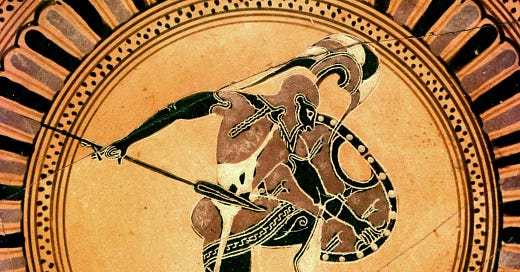The Hoplite: How the Greeks Fought Wars
The Greeks dominated the ancient world through their phalanx warfare tactics.
The Greeks developed a unique way of fighting, called hoplite warfare. The word comes from the Greek hoplites, meaning “soldier.” This word comes from another Greek word, hopla, which was the name of the shield used by Greek infantry.
Hoplite shields were round and large, about three feet across. You grip it from the back. In the middle, there is a leather strip. The shield was made of heavy wood and bronze. It is very heavy, so you need to hold it with your entire arm. The Greeks didn’t allow for left-handed hoplites.
Greek hoplites dominated the battlefield. They crushed their Persian foes, who were equipped with laughably ineffective wicker shields. Unlike the Greeks, the Persians wore pants, which were seen as uncivilized.
Through their superior military tactics and organization, the ancient Greek city-states were able to obtain geopolitical dominance in the Mediterranean.
Armor and shield
The hoplite was equipped with a shield, as well as defensive body armor. He had a bronze helmet, weighing about five pounds. He had a breastplate, made of bronze, as much as 40 pounds. He had shin guards, also made of bronze. The shield itself was made of wood, covered with a bronze sheet, about 20 pounds. In total, a typical hoplite was covered from head to toe.
The helmet was made of strong metal, with very thin slits for sight. It is very hard to see. You can’t see anywhere but straight. Nor can you hear. It was hard to breathe, even though the nose was left open. It was similar to a modern football helmet.
Between the waist and shin guard, there was no armor. That was what the shield was used to cover. Above the shield, was the throat. Below the shield, were the legs. Those were the most common places of vulnerability.
Offensive weapons
In addition to defensive armor, the Greek hoplite had a bronze spear, about 6-8 feet long. The tip was usually made of iron. It had a butt of bronze, which could be lethal. The spear itself was made of wood. Either end of the spear was deadly. It is not clear exactly how the Greeks used their spears, despite the popular depictions of modern movies. A spear could potentially press into a shield, and wack away at the enemy.
The hoplite also had a sword at his side. He didn’t need it if he had a spear, but could rely on the sword in emergencies.
Phalanx
The Greeks aligned themselves in military formations, called a phalanx. It was about eight rows deep. The word phalanx comes from the Greek, meaning a “roller.” This is because, when you saw it from a hill, the formation looked like it was “rolling” up the hill. Anything in the way of a phalanx would be mowed down. The phalanx emerged sometime between 700 and 650 BC, after the earliest city-states were formed.
Hoplites were very vulnerable from the right side. Could a hoplite fight well by himself? Probably not. This is why the hoplites had to be organized into the phalanx formation. Hoplite warfare only make sense in a phalanx.
To maintain a phalanx, the Greeks needed to fight on a flat field. In many cases, Greek hoplites fought against the armies of other Greek city-states. This happened when Greek cities contested frontiers.
The Greeks had to worry about being outflanked. Phalanx armies aimed at being the same size as that of the enemy. Depth was a relevant factor in hoplite warfare. Numbers counted, but it was not a one-to-one thing.
Learn More





